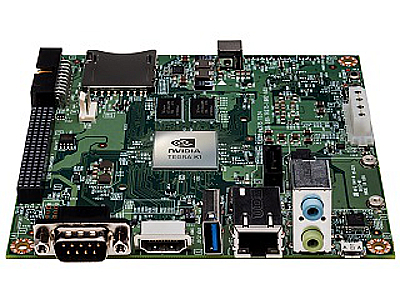Nvidia Now Shipping Tegra K1-Powered Jetson TK1

Itching to get your hands on Nvidia's Jetson TK1? Nvidia's Will Park announced on Thursday that the board is finally shipping, and will be available at Newegg or Microcenter for $192 USD. Dubbed as the first supercomputer for developing embedded applications and devices, the kit contains the board, an AC adapter with power cord, a USB cable for flashing, and a quick start guide.
"Jetson TK1 is a great development platform for computer vision and CUDA applications for robotics, medicine, security, automotive, and defense applications, among others," he writes.
At the heart of this development board is the new Kepler-based Tegra K1, which was revealed earlier this year. The chip is packed with 192 CUDA cores that can be used for general purpose processing when not in use for graphics rendering, delivering more than 300 Gigaflops of computing power. The Tegra K1 is also Nvidia's first mobile chip that is CUDA capable.
"All of Tegra K1's power can be unlocked with CUDA, the same pervasive, easy-to-use parallel processing platform used on Kepler-powered workstations and supercomputers," Park writes.
The board itself was introduced during Nvidia's GPU Technology Conference in March. In addition to the Tegra K1, the board also includes 2 GB of RAM, 16 GB of storage, one half mini-PCIe slot, one full size SD/MMC connector, and a full size HDMI port. The board also provides one USB 2.0 port (micro AB), one USB 3.0 port (A), one RS232 serial port, one ALC5639 Realtek Audio codec with Mic in and Line out, one RTL8111GS Realtek GigE LAN port, one SATA data port, and an SPI 4 MByte boot flash.
On the software side, the board includes Linux for Tegra, a modified version of Ubuntu 14.04 provided by Nvidia. There's also the Board Support Package and software stack, including OpenGL 4.4, as well as CUDA and the VisionWorks toolkit. There's even out-of-the-box support for cameras and other peripherals. Nvidia's partner support networking including Avionic Design, GE Intelligent Platforms, ICD, SECO and Toshiba DME.
Park says the new kit is ideal for robotics, medicine, security, automotive, and defense applications, among others. For more information about the new kit, head here (pdf).
Get Tom's Hardware's best news and in-depth reviews, straight to your inbox.

Kevin Parrish has over a decade of experience as a writer, editor, and product tester. His work focused on computer hardware, networking equipment, smartphones, tablets, gaming consoles, and other internet-connected devices. His work has appeared in Tom's Hardware, Tom's Guide, Maximum PC, Digital Trends, Android Authority, How-To Geek, Lifewire, and others.
-
renz496 Reply13213117 said:Is the Maxwell version delayed until 2015 also?
did you mean maxwell based Tegra? from the last year road map and to the latest road map nvidia expect tegra with maxwell core to show up in 2015. so if they can hit that time frame then there is no delay. -
renz496 Reply13214046 said:No OpenCL support? Figures, I suppose.
at the very least nvidia was clear about that. in the past nvidia has mention that they intend to use CUDA as their advantage over OpenCL. -
icrf Did i miss what CPU cores are in the SoC? I imagine we're still waiting on Denver, so does that make this a quartet of A15s? I realize the GPU is the noteworthy part, but if the audio DAC gets a mention, the CPU can get a note, too.Reply -
allenpan why do u want OpenCL when there is CUDA (yes I have experience with both CUDA & OpenCL for my Grad Project: Autonomous Robot using Kinect with GPGPU Assistance.Reply
serious CUDA is much easier to troubleshoot and resource friendly! -
David Whapham This tiny little board is faster then every super computer that existed in the world before the year 1997 - and it costs less than $200.00. How awesome is that!Reply -
Frank Tizzle Replydid you mean maxwell based Tegra? from the last year road map and to the latest road map nvidia expect tegra with maxwell core to show up in 2015. so if they can hit that time frame then there is no delay.
I was merely being sardonic, knowing that 20nm Maxwell GPUs aren't until 2015. -
icemunk It's a nice little SoC. About 300 gigaflops, which is near what an Xbox 360 had. The newer Ardeno chips in the Snapdragon 801 are only at about 150 gigaflops, so this is a good incremental leap in mobile GPU power. The other chip right now sitting in the same arena is the Mali-760 (mp16), with about 326 gigaflops of GPU power. It's very nice to see so much power being put into these devices. I wouldn't call it a super-computer, but it is quite capable. In a year or so I can see us reaching teraflop mobile GPUs.Reply -
SirKnobsworth Replywhy do u want OpenCL when there is CUDA (yes I have experience with both CUDA & OpenCL for my Grad Project: Autonomous Robot using Kinect with GPGPU Assistance.
serious CUDA is much easier to troubleshoot and resource friendly!
If you don't care about vendor lock, it's probably not an issue, but that's not always the case.